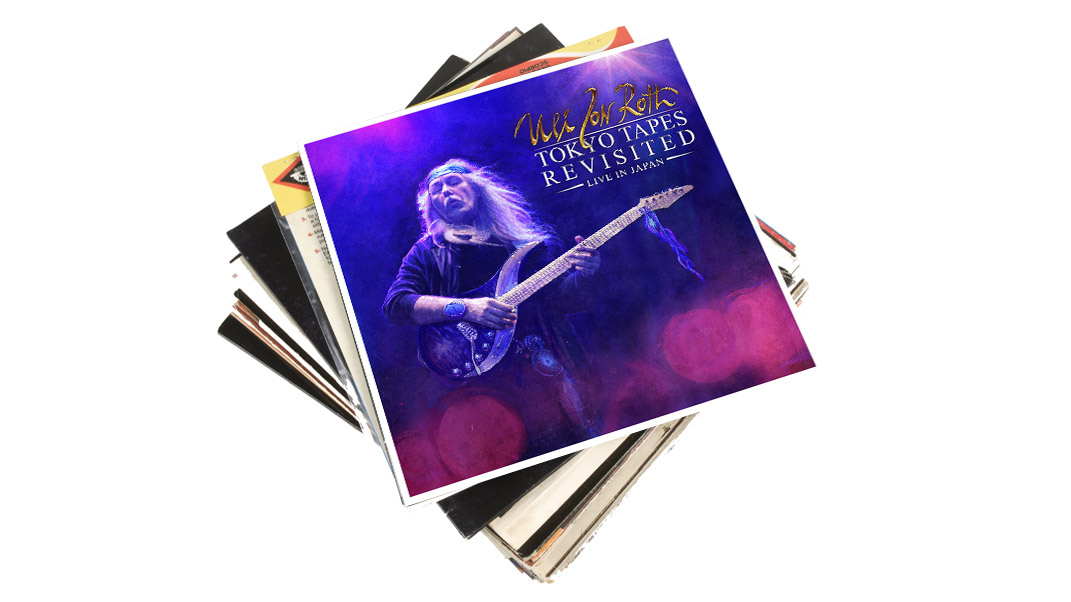Uli Jon Roth: my top 5 tips for guitarists
Ex-Scorpions guitar icon on technique and his return to Tokyo

Tokyo Tapes Revisited
In April 1978, Germany’s Scorpions walked into Nakano Sun Plaza and made rock ’n’ roll history.
Initially released months later exclusively to Japan before finally making its way to American record stores the following year, their first live album - entitled Tokyo Tapes - was an absolute tour-de-force of heavy hitting hard rock.
Lead guitarist Uli Jon Roth, who also sang on a handful of the songs, stunned the world with choice notes and buckets of feel… in many ways, it was the release that cemented his place among the true greats.
Uli Jon Roth returned to the venue, not for the first time but very well perhaps the last, in February 2015 - and his visit was documented for new release Tokyo Tapes Revisited, delving deep inside his five-year stretch in one of the most successful German bands of all time.
“It was a really special day for all of us,” remembers the guitarist.
“Though it wasn’t the first time I’d been back to the Plaza, I believe it will be the last time because I’ve been told the venue will be demolished for the Olympic Games. That was almost the starting point for this; I thought it would be good to do a farewell concert for the venue, because I felt Tokyo Tapes were my most important shows. The hall still has a beautiful sound that’s identical to how it used to be.
“As you can imagine, it’s a bit nostalgic for me! I didn’t have much time on the day because we were filming for Japanese television, but all in all, it was a very exciting day and show, and I’m glad it’s been captured.”
Having been using his own self-designed custom Sky guitars since the '80s - fitted with up to an extra octave of frets - there was no question what axe he’d be playing on the night. As it turns out, he stuck to just one single instrument for an overwhelming majority of set.
Technically, my top frets are spaced a whole tone apart, so most people would count those as two. I have that spacing to get a real singing tone high up there in the stratospheric regions
“Apart from a classical Godin nylon seven-string in the middle of the set for some improvisation, I just used one of my favourites for the whole show,” he reveals.
“I’m not sure how many frets it has; they’re all a bit different… maybe 35 or 36 or something like that. I don’t think in terms of frets; I think in terms of pitch. Technically, my top frets are spaced a whole tone apart, so most people would count those as two. I have that spacing to get a real singing tone high up there in the stratospheric regions. The original ones struggled to get a good sound with semitone steps, which made good tone harder due to lack of space for the fingers.”
Behind him were three full stacks of Blackstar cabs fed by two Blackstar 100-watt Artisan hand-wired heads and the original Marshall Super Lead Tremolo used on all the Scorpions albums.
“I don’t really look for new gear, not at all,” offers the guitarist. “I usually get a lot of pedals to try out at trade shows, but on stage I tend to use a small selection of my favourites. I wouldn’t even call myself a pedal freak…”
Here he gives us five tips to musical godliness, or as he prefers to call it, the five common diseases of guitar playing…
Tokyo Tapes Revisited is out on 16 December via UDR Music.

1. Right of passage
“Just five tips? This is like the question from hell. Even good guitar players are neglectful of rhythm playing or rhythmical playing. They tend to have a sloppy right [picking] hand. It’s very important to make sure that your right hand can employ a variety of picking styles. They all sound different and I always find it questionable to use just one… everything sounds same-y, and it’s not as flexible.
“Work with a metronome and concentrate on achieving a flexible and dynamic right hand with which you can accurately pick notes at different energy levels. Phrasing has a lot to do with placing accents. Some notes are designed to be twice as loud as others. That gives meaning to music, rather than the slack approach people often employ, which I find boring to listen to.
“Assess your right-hand abilities and help it develop a life and mind of its own. With lead guitar players, it can be more of a passive bystander in their skills. It’s the most common lead guitar player disease, especially for those who play in the high-gain field - it’s the kiss of death when it comes to definition… almost a form of lying to yourself about sloppy and underdeveloped technique.”

2. Left hand path
“The same goes for the left hand. Most players will have a preference; they’ll know one hand is more developed. It depends on whether you’re more rhythmically or melodically inclined. Ideally, you should strive for an equal development of both hands so that they both work perfectly in harmony together. That means the left hand needs a strong sense of rhythm, position, with all fingers stretched evenly and able to do whatever you need independently.
Your four digits are like the dancers, but the thumb is like the controller mastermind behind the curtain, running the show
“I still use various [chromatic] exercises for this that I learned when I was kid! If you use your ears, you’ll be able to tell whether there’s room for improvement. Look at the accuracy of the rolling movements, finger by finger. The thumb should completely flexible, too. Your four digits are like the dancers, but the thumb is like the controller mastermind behind the curtain, running the show.
“Be firm and flexible, using the right amount of pressure. I use scalloped necks which tell me exactly when too much pressure is applied. The guys that use too much pressure push notes horribly sharp on a scalloped fretboard… you’ll hear that jerkiness in their playing.
“There are guys that play lightly with their left hand, which also sounds flaccid-sounding, with little definition or response from the strings. Find exactly the right amount of pressure.”

3. See the notes you play
“Expression is very important. Every angle the pick attacks the string will give you different sounds and colours, which adds to the expression in your tone. That can be used in conjunction with your left hand being steady or a moving note that has vibrato.
“There are an infinite amount of ways to do vibrato - you could go precisely in time with the music in triplets or semi-quavers, or you could start slowly, speed up in the middle and then taper off… almost like a bird increasing its speed of flight.
“These concepts need to be investigated because they are important colours you can add to your music. The more you have at your disposal, the more interesting your playing will be, provided you know when enough is enough.
It’s in the fingers, but at the end of the day, the real master is your mind
“Apply these tools with good taste. Some people seem to overdo everything where it’s very mannered… or underdo everything to the point where it gets predictable - boring, to my ears. It’s in the fingers, but at the end of the day, the real master is your mind.
“Try to see the notes clearly in front of you while you play. I seethem - I can literally feel the movement of the string with my whole body. It’s almost like an extremely tunnel-visioned lens extending from my mind through the tip of my fingers and into the end of the note. It’s hard to explain, but that’s how it feels!
“And the more you feel, the better the outcome. It can be microscopic and macroscopic; you have to sit back so you can see the whole picture. Luckily, our minds are perfectly capable of doing that because we all have a bit of split personality, or at least should be able to do that. Every artist will know what I’m talking about here!”

4. Tone comes from the mind
“Choice of tone is one of the weakest areas for most modern players. Somewhere in between the late-'70s and 2000s we had a major casualty in the guitar community… the feeling for tone! It’s a result of our natural tendency to choose the easy way out and go for the lowest common denominator.
“To produce a great guitar tone you need a lot of imagination. You need to hear it inside yourself and want it. The process takes effort: it’s not easy - you need the right guitar and the right amp.
“You need to adapt your playing to create the right sound. I went as far as buying houses according to sound… that’s the true extent of my deranged mind. I’ve become more normal now, in later age, but I’m still searching for the perfect tone. It’s always difficult. I know some players out there have a great tone most of the time and sound like themselves, but always use the same equipment.
A lot of players sound the same and play with super-high gain. It’s the kiss of death for any real statement of tonal quality
“It’s very much a mental thing: imagine your tone. Use the vision of your subconscious. I’ve never sat down and wanted to sound like Uli Jon Roth; I just wanted to make the sounds I could hear in myself.
“A lot of people don’t have the desire any more, so a lot of players sound the same and play with super-high gain. It’s the kiss of death for any real statement of tonal quality. From a distance it can sound okay, but when you’re really exposed to it for longer periods of time, it’s awfully flat and meaningless. I really don’t like it!”

5. Learn to listen
“This isn’t just a lead player disease; it goes for all musicians. There’s a lack of willingness to see the whole picture. Most guitarists tend to want to play flashy leads - it’s more like an ego trip of fast scales and arpeggios that sound empty. They get played at breakneck speed without any meaning whatsoever, bypassing 99% of the music-loving public.
“The era I come from, in the late-'60s and early-'70s, flashiness virtually didn’t exist. Every guitar player strived for expression that related with the music and touched people in a deeper emotional way. Nowadays, younger players are spoonfed all the licks of the previous generation, but it’s very rare that I hear someone who actually can make sense musically. They blast through certain scales or use certain bends all the time - it feels like there’s no novelty left.
In some regards, the guitar is still in puberty… there’s plenty to be discovered still
“I would advise the guitar community to go out and search for new ways of expression, because there’s plenty left! In some regards, the guitar is still in puberty… there’s plenty to be discovered still. Get out there and bring it to the table. Don’t try to be original for originality's sake. Be grounded in every aspect of your musicality, especially technique.
“Don’t try to impress or be flashy - the music already gives you framework. Listen deeply to the music, starting with single notes, building up to little phrases. Then think about harmonies and rhythms and everything else that exists in the laws of music. The same laws govern us on a mental, physical and spiritual level - music has the key to everything as long you know what you’re looking for. Play with heart and soul, rather than cold mechanical stuff with no feeling.”
Amit has been writing for titles like Total Guitar, MusicRadar and Guitar World for over a decade and counts Richie Kotzen, Guthrie Govan and Jeff Beck among his primary influences. He's interviewed everyone from Ozzy Osbourne and Lemmy to Slash and Jimmy Page, and once even traded solos with a member of Slayer on a track released internationally. As a session guitarist, he's played alongside members of Judas Priest and Uriah Heep in London ensemble Metalworks, as well as handling lead guitars for legends like Glen Matlock (Sex Pistols, The Faces) and Stu Hamm (Steve Vai, Joe Satriani, G3).
